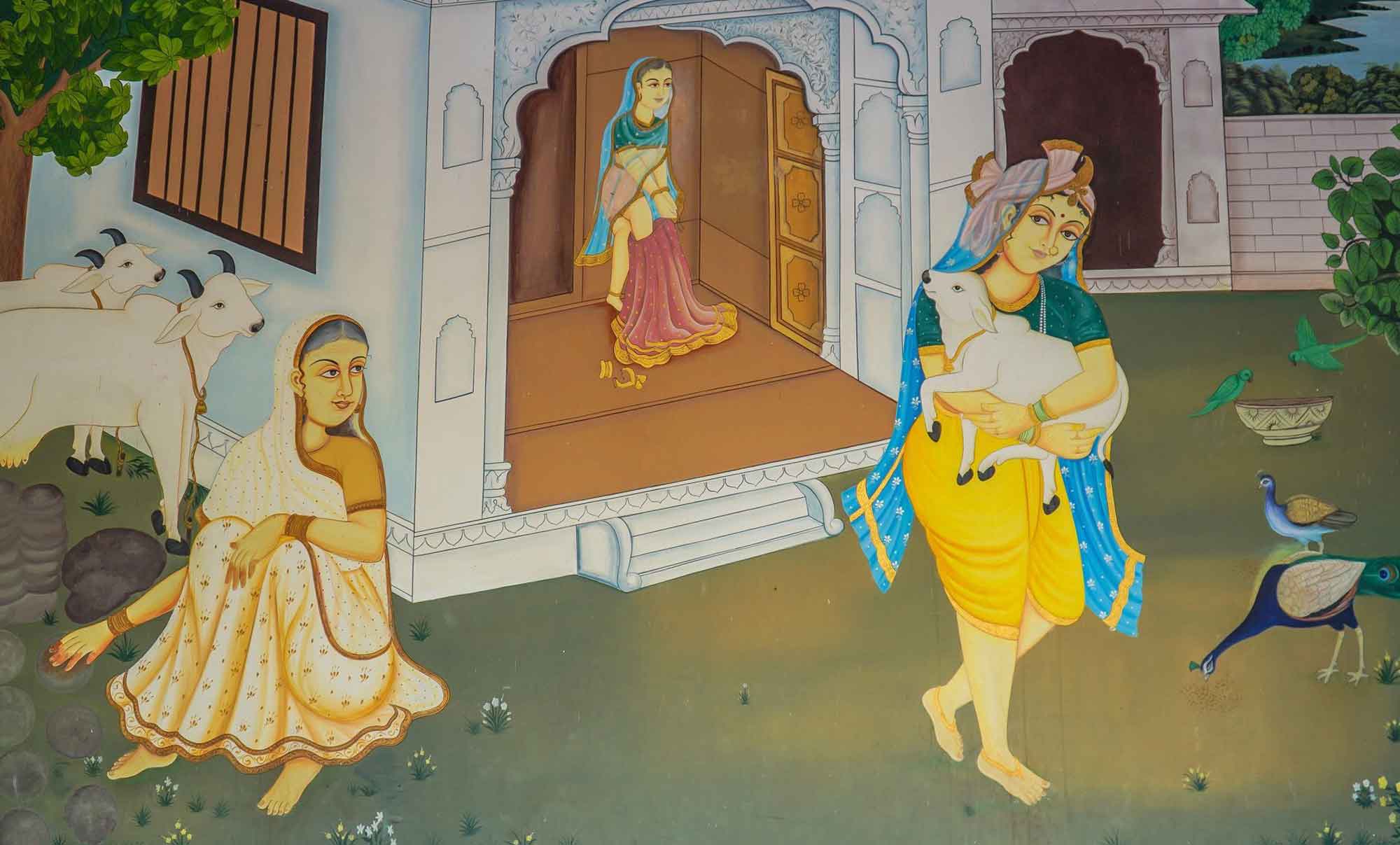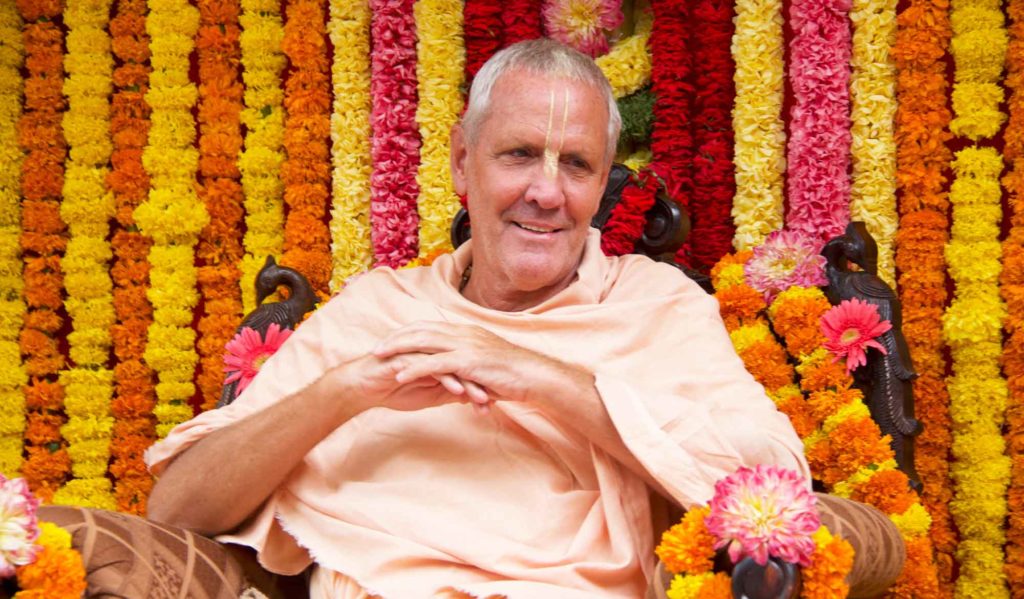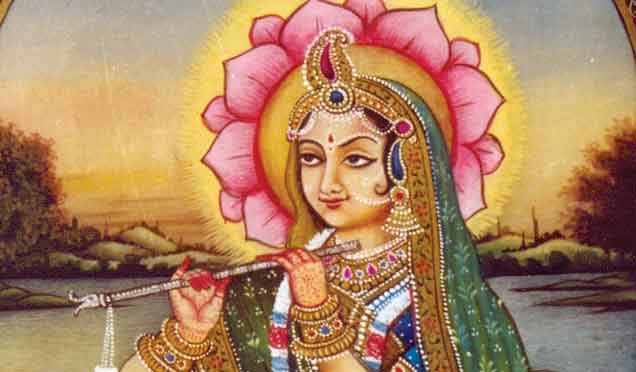Overview
‘Rādhā-Pāda Darśana’ was written by Swami B.G. Narasingha on November 6th 2009. In this article, Swami Narasingha describes the pastime of Subala Milana, when Rādhārāṇī dressed as Subala to meet Kṛṣna. Narasingha Maharaja also gives a deeper purport to this pastime.
This year, on October 31st, on the Śukla-pakṣa Trayodaśī during the month of Kārttika, devotees celebrated the day that Śrīmatī Rādhārāṇī dressed in Subala-veśa – the dress of the cowherd boy Subala. In the dress of a cowherd boy, the lotus feet of Rādhā are visible during darśana. This is called rādhā-pāda-darśana and only happens one day in a year. Indeed, it is a rare occasion. Thousands of devotees packed the courtyard of the Rādhā-Dāmodara Temple from morning to night with great expectations of glimpsing the lotus feet of Śrī Rādhā.
The pastime of Rādhā accepting Subala-veśa (Subala-milana) is described in the book Saṅkīrtanāmṛta, written by a recognised Vaisnava named Dīna Bandhu Dāsa who followed after the time of Viśvanātha Cakravartī Ṭhākura. Śrīla B.R. Śrīdhara Deva Gosvāmī summarises Subala-milana as follows:
“Sometimes Subala played proxy for Rādhārāṇī. One day in the pasture ground, Kṛṣṇa suddenly felt extreme separation for Rādhikā. Kṛṣṇa sent for Subala, ‘Oh my Rādhā – please go and fetch Her, I can’t live without Her. Suddenly I have so much earnestness for Her union that I can’t stand. Somehow you must manage.’
Subala replied, ‘But how is it possible to take Her in the jungle in broad daylight?’
‘Anyhow,” Kṛṣṇa said, “You must manage.’
Subala came and proposed to the sakhīs of Rādhārāṇī that, “Such is the condition, Kṛṣṇa can’t stand; He can’t tolerate the separation of Rādhārāṇī. He is so eager, He is going mad.”
‘You have to manage somehow.’
‘How is it possible?’
A meeting was to be arranged nearby in the jungle. This is known as Subala-milana. They discussed amongst themselves. Subala was a boy, fair looking. His figure, face and colour resembled something like Rādhārāṇī. So Subala was sent to Rādhārāṇī’s house and he took the dress of Rādhārāṇī. The other party, anti-party (Jaṭilā) approached, “Subala, why have you come here?”
Subala replied, ‘One calf is missing and its mother is roaring, so I have come to find out if the calf has come here.’
In this way Subala managed to escape detection. Then Subala interchanged the dress of Rādhārāṇī and Rādhārāṇī was converted into Subala. Subala took the dress of Rādhārāṇī and remained there in the room. One calf was also given to Rādhārāṇī on Her breast. Taking the small calf (in Her arms), She was given a hint where Kṛṣṇa was waiting at the edge of the jungle.
She approached in the garb of Subala. Kṛṣṇa was mad and beside Himself. He could not detect that Rādhārāṇī had come. ‘Oh, Subala, You have come back? You could not bring Her?’
Rādhārāṇī began cutting jokes, ‘No, it is not very easy to get Rādhārāṇī in the daytime.’
Then Kṛṣṇa could not tolerate, ‘What to do, I can’t tolerate My life any longer!’
Rādhārāṇī said, ‘If you say, I will bring Candrāvalī.’
‘No, no’, said Kṛṣṇa, ‘Curd cannot satisfy the thirst of milk. It is not possible. Oh, you could not manage.’
And being disappointed Kṛṣṇa fainted. Then Rādhārāṇī embraced Kṛṣṇa.
‘My Lord, you can’t recognise Your maidservant. You failed to recognise Me? You have such little liking for Me in You that You could not recognise Me?’ Then Kṛṣṇa was again pacified and regained consciousness.”
*****
In Vṛndāvana, to commemorate this pastime, on the Śukla-pakṣa Trayodaśī, all the major temples dress Rādhārāṇī as Subala. Due to Her wearing a cowherd boy’s dhotī, Rādhārāṇī’s feet are visible at that time (rādhā-pāda-darśana).
During all other times of the year the feet of Śrīmatī Rādhārāṇī are not visible to the devotees. One can thus imagine what intensity arises in the devotees when the day of rādhā-pāda-darśana arrives — very, very intense indeed.
It is worthy to note that when rādhā-pāda-darśana is given, it happens in an indirect way and not directly. In the dress of Rādhā the pāda-darśana is never given, but in the dress of Subala it happens indirectly. Such is the way of those things that are most sacred in Gauḍīya Vaiṣṇavism.
The understanding of Subala-milana is possibly deeper than most of us are prepared to recognise. Kṛṣṇa can only be approached thru Rādhārāṇī, and Rādhārāṇī is also not to be approached directly. Only by approaching Her representative can one approach that plane of divinity. Also, we must consider that even in the matter of the darśana of Śrī Mūrti, the darśana of Rādhā’s lotus feet is available only indirectly and only once a year — a rare occasion.
When such a darśana of the Deity is considered so rare, then what can be said of the darśana of Rādhārāṇī directly? If such a connection with the Deity is rare, then how much higher and rarer is the direct darśana of Śrī Rādhā?
Yet, ever so often, we find that the concept of rādhā-dāsyam (becoming Rādhā’s servant) is dealt with rather casually, when in fact one should hold the desire of such exalted service above one’s head with the greatest reverence. Reverence for that highest plane of spiritual attainment is in great demand and thus one should treat such with the greatest respect, abandoning familiarity.
Familiarity in that arena for the neophyte will lead not to success but to ruin. The aspiration for the service of Śrī Rādhā and the darśana of Her lotus feet is always to be kept above our heads as our greatest aspiration and the ultimate goal of life. We should not think that it is such an easy attainment, nor should we make it the topic of public lectures and pamphlets in the name of attracting many followers or disciples.
Failure to heed such warnings, as given by our previous ācāryas, lead not to the darśana of Śrīmatī Rādhārāṇī but to the inspiration to live in a fool’s paradise — fools rush in where angels fear to tread!
Those that approach the lotus feet of Śrīmatī Rādhārāṇī thru the prescribed method of worshipping Lord Gaurāṅga in saṅkīrtana are indeed engaged in the proper approach – not those who think they can approach Her directly by performing various concocted gopī and mañjarī meditations. As Prabodhānanda Sarasvatī assures us:
yathā yathā gaura-padāravinde
vindeta bhaktiṁ kṛta-puṇya-rāśiḥ
tathā tathotsarpati hṛdy akasmāt
rādhā-padāmbhoja-sudhāṁbu-rāśiḥ
“One who is extremely fortunate may get the mercy of Caitanya Mahaprabhu. As much as one can devote his full attention to the lotus feet of Lord Caitanya, to that extent he will be able to taste the nectarine service of the lotus feet of Śrīmatī Rādhārāṇī in Vṛndāvana. The more one engages in the service of Śrī Caitanya, the more one finds oneself in Vṛndāvana, tasting the nectar of the service of Śrī Rādhā.” (Caitanya-candrāmṛta 88)
Purporting this verse Śrīla Śrīdhara Deva Gosvāmī spoke as follows:
“Śrīla Bhaktivinoda Ṭhākura has also said, “Stick to the rulings of the class you are fit for, then you will see automatically.” Strictly stick to gaura-līlā, Mahāprabhu, and you will automatically find within your heart that rādhā-rasa-sudhā-nidhi is flowing. Don’t attempt directly to have it. It will come automatically, spontaneously. Not intellectually you shall approach that, for that will give you a bad prejudice. Not only that, but it will be harmful prejudice and you will have to expend more energy to do away with that layer of misunderstanding. So our Śrīla Prabhupāda (Bhaktisiddhānta Sarasvatī Ṭhākura) did not allow these things. Do your duty in your plane, according to what you deserve, and that will come naturally. That is his instruction all through, not only temporarily, but all through. Don’t do like that, for then you will get Māyā instead of Yogamāyā.
He knows it fully well, She knows it fully well – when you are to be taken into the confidential area, and that cannot be acquired by any other thing but His sweet will—the flow of Her sweet will, or His sweet will. Try to have the natural thing, not anything of imitation or any reflection. Reflection and shadow – these two kinds of misconception may come there. Reflection is more dangerous.”
Those who are actually wise will consider the above instructions of Prabodhānanda Sarasvatī, Bhaktivinoda Ṭhākura, Bhaktisiddhānta Sarasvatī and Śrīdhara Deva Gosvāmī not as an admonishment, but as a blessing – an indirect benediction. Gaura-haribol!
Related Articles
- Śrī Śrī Rādhā Kṛṣṇa & The Fountainhead of All Tattvas by Śrīla Bhakti Pramoda Purī Gosvāmī
- A Prayer Composed on the Occasion of the Disappearance of Śrīla Gadādhara Paṇḍita by Śrīla Bhakti Pramoda Purī Gosvāmī
- The Appearance of Śrīla Gadādhara Paṇḍita by Śrīla Bhakti Rakṣaka Śrīdhara Deva Gosvāmī
- Śrī Śarādīyā Pūjā by Śrīla Bhakti Rakṣaka Śrīdhara Deva Gosvāmī
- Śrī Lalitā Devī and Śrīmatī Rādhārāṇī by Śrīla Bhakti Rakṣaka Śrīdhara Deva Gosvāmī
- The Appearance of Rādhā-kuṇḍa by Śrīla Bhakti Rakṣaka Śrīdhara Deva Gosvāmī
- From Śraddhā to Prema by Śrīla Bhakti Gaurava Narasiṅgha Mahārāja
- Gāyatrī as Rādhārāṇī by Śrīla Bhakti Gaurava Narasiṅgha Mahārāja
- My Guru is Rādhārāṇī by Śrīla Bhakti Gaurava Narasiṅgha Mahārāja
- The Greatest Negative by Śrīla Bhakti Gaurava Narasiṅgha Mahārāja
- Śrī Rādhāṣṭamī by Śrīla Bhakti Gaurava Narasiṅgha Mahārāja
- Śrīla Śrīdhara Mahārāja and the Gem of All Conceptions by Śrīla Bhakti Gaurava Narasiṅgha Mahārāja
- Planets of Faith by Śrīla Bhakti Gaurava Narasiṅgha Mahārāja
- Rādhā-Pāda Darśana by Śrīla Bhakti Gaurava Narasiṅgha Mahārāja
- The Definition of Faith by Gaura Gopāla Dāsa
Further Reading
Prema Dhāma Deva Stotram with the Narasiṅgha Sevaka Commentary – Verses 61-65
In verses 61 to 65 of 'Prema Dhāma Deva Stotram', Śrīla Śrīdhara Mahārāja narrates the pastime of Śrī Caitanya at Caṭaka Parvata In Purī and explains how the scriptures produced by Brahmā and Śiva are ultimately searching for the personality of Mahāprabhu who is merciful too all jīvas, no matter what their social position.
Prabhupāda Śrīla Sarasvatī Ṭhākura’s Visit to Ayodhyā
With the forthcoming observance of Śrī Rāma Navamī, we present 'Prabhupāda Śrīla Sarasvatī Ṭhākura’s Visit to Ayodhyā' written by Śrīla Bhaktisiddhānta Sarasvatī Ṭhākura Prabhupāda from The Gaudīyā magazine, Vol 3. Issue 21/ In December 1924, after visiting Benares and Prāyāga, Sarasvatī Ṭhākura visited the birth-site of Śrī Rāmācandra in Ayodhyā.
Śaraṇāgati – The Only Path to Auspiciousness
In this article, 'Śaraṇāgati - The Only Path to Auspiciousness', Dhīra Lalitā Dāsī analyses the process of śaraṇāgati (surrender) beginning with śraddhā (faith). She also discusses the role of śāstra and the Vaiṣṇava in connection with surrender.
Ātma Samīkṣā – The Value of Introspection
In this article, "Ātma Samīkṣā – The Value of Introspection" Kalki Dāsa highlights the importance of introspection in the life of a devotee and especially in relation to the worldly environment that surrounds us. He also explains how transcendental sound influences our capacity to introspect.
Prema Dhāma Deva Stotram with the Narasiṅgha Sevaka Commentary – Verses 61-65
In verses 61 to 65 of 'Prema Dhāma Deva Stotram', Śrīla Śrīdhara Mahārāja narrates the pastime of Śrī Caitanya at Caṭaka Parvata In Purī and explains how the scriptures produced by Brahmā and Śiva are ultimately searching for the personality of Mahāprabhu who is merciful too all jīvas, no matter what their social position.
Prabhupāda Śrīla Sarasvatī Ṭhākura’s Visit to Ayodhyā
With the forthcoming observance of Śrī Rāma Navamī, we present 'Prabhupāda Śrīla Sarasvatī Ṭhākura’s Visit to Ayodhyā' written by Śrīla Bhaktisiddhānta Sarasvatī Ṭhākura Prabhupāda from The Gaudīyā magazine, Vol 3. Issue 21/ In December 1924, after visiting Benares and Prāyāga, Sarasvatī Ṭhākura visited the birth-site of Śrī Rāmācandra in Ayodhyā.
Śaraṇāgati – The Only Path to Auspiciousness
In this article, 'Śaraṇāgati - The Only Path to Auspiciousness', Dhīra Lalitā Dāsī analyses the process of śaraṇāgati (surrender) beginning with śraddhā (faith). She also discusses the role of śāstra and the Vaiṣṇava in connection with surrender.
Ātma Samīkṣā – The Value of Introspection
In this article, "Ātma Samīkṣā – The Value of Introspection" Kalki Dāsa highlights the importance of introspection in the life of a devotee and especially in relation to the worldly environment that surrounds us. He also explains how transcendental sound influences our capacity to introspect.








